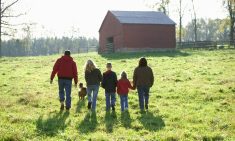These new peer groups are drawing rave reviews from their members. Are they the most inspirational and perhaps the most essential business idea of the new millennium? It’s a big claim, but it’s tough to argue against this newest iteration of farmers helping farmers.
Though farmer peer groups aren’t yet very common, they are a growing trend among agriculture’s most proactive farmers, says Tim Schaefer. Born and raised on a farm, Schaefer now runs Encore Consultants in Morris, Minnesota. In addition to helping individual farmers navigate succession planning and scaling up, Schaefer facilitates groups of farmers from both sides of the border in farmer peer groups.
Read Also

The big squeeze: How to be fair to siblings during farm succession
Managing sibling business relationships on family farms.
“Farming has become easier with technologies like RoundUp Ready crops and precision ag. The difference between the really great and the marginal producer has narrowed a lot,” he says. “The next frontier in farming is management and professionalism. That’s what farmers who commit to a peer group are really investing in.”
Peer groups suit progressive farmers who want to grow, agree farmer Kristi Nylen-Burns and Schaefer. In Nylen-Burns’s group (see previous story), virtually all participants are in their 30s and 40s, are open to change, and expect to expand in the coming years.
In Schaefer’s groups, most of the farmers are top-of-the-heap performers who are becoming limited by the status quo.
“At some point you become maxed out and realize you can’t create scale by putting more through one person. So you have to ask: how do I become more of a leader and less of a day-to-day manager?” says Schaefer. “Peer groups have come about because there is increased demand for high-level thinking.”
The first meeting
Farmers who first start with a peer group usually follow a similar path: mild to moderate anxiety at the outset, then appreciation, then overwhelming commitment to and belief in the group.
“There is always a little bit of trepidation when farmers first meet (at the first peer group meeting),” says Schaefer. “I think the first question is, ‘Who are these people?’ They’re strangers. And then, ‘What am I going to get out of it?’ and maybe ‘How am I going to get out of it?’”
After the first meeting, Schaefer asks participants if the peer group seems to be what they thought it would be. Participants always say no.
“The assumption is that a peer group is just a souped-up coffee shop, unstructured, rambling, full of egos. They realize that’s not it at all,” he says. “What they get out of it is they can see what’s working and not working on other people’s operations. They can see their challenges through a different light, learn from farms that have already cracked some specific nut.”
Schaefer says much of his groups’ time is spent discussing how to be a better employer.
“Employee satisfaction is one of the very top issues we look at with 100 per cent of farms we work with,” he says. “Now and into the future, the biggest hurdle to scaling up will be finding people to do the work in a declining rural population. More and more businesses are chasing fewer and fewer bodies. The farms really scaling up need to have the employee engagement piece dialed in.”
Peer groups can be structured in multiple ways, though most share strong similarities. Kristi Nylen-Burns’s peer group is made up of similar-minded, progressive farmers who grow annual crops (mostly grain and oilseeds) across Western Canada.
Schaefer builds his peer groups a little differently. He groups farmers who share similar challenges even if they work in differing commodities.
“The group we’re starting right now, there’s a dairy operation and an apple orchard in it. The whole point is that they both deal with immigrant labour and they both deal with end-product food stuffs. You might not initially imagine putting those two together, but there’s commonality,” says Schaefer. “I hear all the time: ‘I’m a grain farmer. I hang around with grain farmers all the time. If I’m going to have a breakthrough idea, I want outside-the-box thinking.’”
The case-study approach
Schaefer’s peer groups meet twice a year, each time at a different group member’s farm. That farmer becomes the ‘Case Study’ for that session. After intensive discussion with multiple members of that farm’s operating (and sometimes extended) circle, the group comes up with five action items that will move that case study’s farm business rapidly forward within the upcoming six months. The formula kick-starts action and enforces accountability.
It’s not just the case study farmer who gains value from the process, however, says Schaefer.
“A lot of the time when we go around the circle offering advice at the end of the session, people will say, ‘I understand it’s hard to have your pride and joy critiqued. As I give you this advice, I want you to know I’m giving my farm the same advice.’”
Discussion topics in an effective peer group should cover all parts of the management spectrum, from business structure, marketing and finance to human resources, strategic planning and succession planning. While farmers should talk numbers too, benchmarking and financial comparisons typically happen less than you might guess.
“Benchmarking against others’ performance is only a small component of a peer group,” says Schaefer. “Benchmarking is a backwards-looking thing that says: this is what happened; what adjustments do we need to make for the future? A peer group is forward looking. It’s about building vision.”
What peer groups should benchmark, however, are things like how many hours a farmer works, the benefits and pay they offer employees, and how many acres they can expect per employee hour: apples to apples comparables that allow a farmer to rethink strategic plans, policy and expectations.
Are you ready for a peer group?
Could a peer group could be in your future? First, make sure you and your business are ready to take up the challenge.
To be a good candidate for a peer group, you need to be progressive, you need a willingness to invest openly and honestly in the group, and you need to want to grow, says peer group facilitator Tim Schaefer of Encore Consultants in Minnesota.
“It doesn’t have to be rapid growth but you have to be hungry, not mired in the status quo,” Schaefer says.
Numbers aren’t everything in a peer group, but they are important. Therefore, you need to understand your farm’s accounting more intimately than just simple tax accounting.
“You need to know your numbers so we’re not just talking hypotheticals,” he says.
In terms of size, farms with five or more employees typically get the most out of a peer group.
“If you map out all the communication interaction between five people, it is a very complicated path,” says Schaefer. “Acres add complexity but people add more complexity faster.”
Both Kristi Nylen-Burns and Schaefer agree that one of the very most important factors of a peer group’s success is each members’ willingness to prioritize the peer group. Your peer group depends on your input: skipping sessions or investing half-heartedly is not an option.














